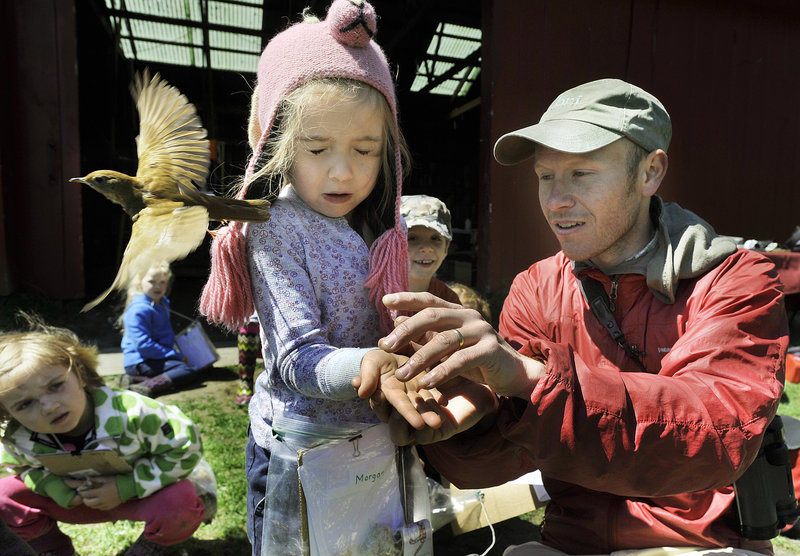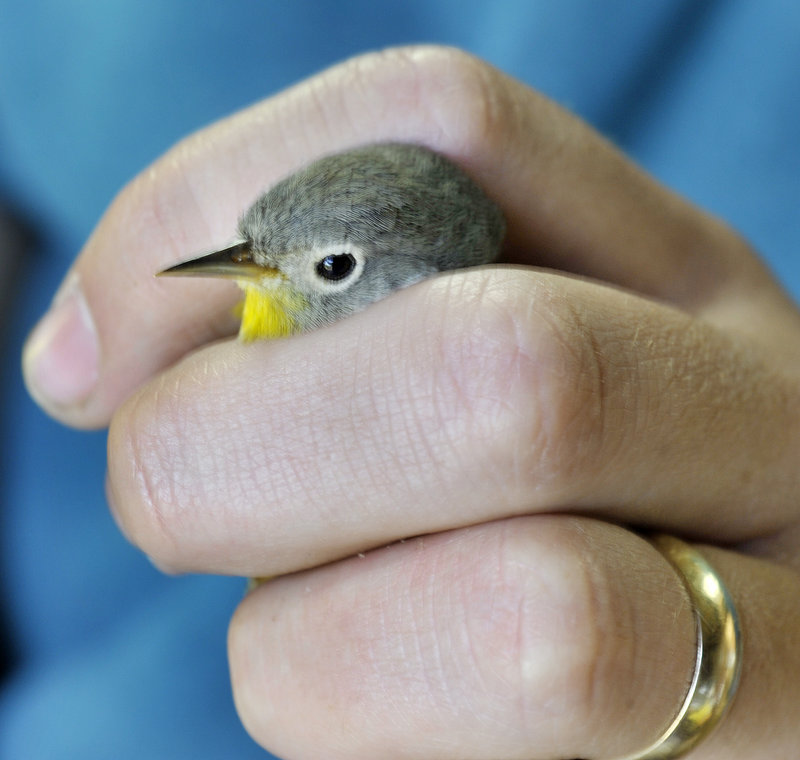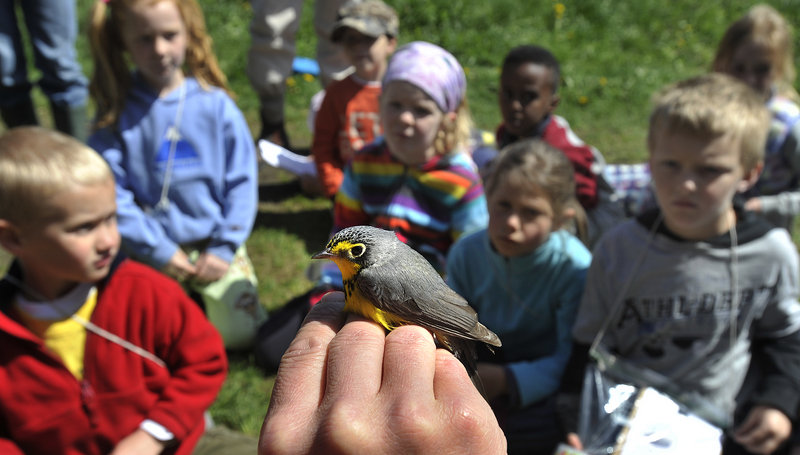The kindergartners and first-graders can’t quite believe their eyes: Live little birds in small cotton bags that can fit in the palms of their hands. And then take flight.
On this sunny morning at the Audubon Preserve at River Point in Falmouth, about 25 children from the Waynflete School in Portland sit in a semicircle in front of the open barn doors, where biologist Patrick Keenan is demonstrating the process of bird banding.
Keenan holds a small warbler in his left hand, gently aligning his fingers like bars through which the bird peers at the schoolchildren.
“This is a magnolia warbler,” said Keenan, outreach director of the Biological Research Institute in Gorham. “Who can tell me what it eats?”
“Flowers?” piped a little girl in the back row.
“That’s a good guess,” said Keenan. “But actually this guy … eats insects.”
While this was an exercise in education, bird-banding — like the long-term observations of bird-watchers across the state — has come into its own as a scientific method to monitor birds’ movements and behavior. Scientists say that the migratory variations revealed by banding can shed light on such important issues as climate change, persistent toxic chemicals in the environment and habitat loss.
Banding presents scientifically reliable information to study not only behavior and patterns among birds but also disease and pollution, Keenan said. And that information turns out to have correlations to human medicine. For example, surveys of Eastern equine encephalitis in bird blood have been conducted at River Point, he said.
At the Audubon preserve, Keenan moved around the front of the gathered children, his hands circling in a wide arc like a farmer scattering seed to chickens. He holds onto the warbler as he swings one way, then the other, giving everyone a close look.
“Who’d like to let him go?” asked Keenan.
A half-dozen children leap to their feet, raising their hands like hatchlings flapping.
“Can I?” said one, performing a little leap, the better to be seen and heard.
“Can I?” peeped another. “Can I?”
Keenan later said banding can nurture an awe of wildlife. “It’s a pretty powerful and amazing thing … to handle a bird and hand it to someone and they let it go,” he said.
In order to obtain permission to capture birds for banding, the state Department of Inland Fisheries and Wildlife requires that the intent must be to gather information for research.
Each bird that wings into one of the 10 mist nets spread across 10 acres at River Point lies in a hammock-like cradle of thin black netting, suspended in midair, so that predators are unable to reach it. With its feathers pinned lightly against its body, it remains there, until it is recovered during monitoring checks conducted every half-hour. When retrieved, each bird is placed in a small cloth bag, somewhat like a pillow case.
To gather banding information, a numbered aluminum ring (imprinted with a contact phone number and Web address) is placed on the right leg of each bird. Each nine-digit ID number is unique, something akin to an avian Social Security number, according to Judy Camuso, an IFW biologist.
The number enables anyone to retrieve the bird and help track it, no matter where it turns up.
Recovered birds at River Point are identified, weighed and measured, including their wing length, age and body condition — feathers, feet and fat — to find out how they are faring and, perhaps, whether they are breeding.
The data gathered from banding reveal migration (arrival and departure times and destinations), behavior, mating fidelity and preference of habitat. Some of the earliest records trace back to the 1500s.
“At River Point, we’re interested in timing, abundance and diversity of migratory songbirds,” said Keenan, who has banded for three years in the 41-acre sanctuary at River Point.
Data from other species, including game birds, are analyzed in many locations across the U.S. and are essential in detecting changes, especially in sizes of populations, according to the Bird Banding Laboratory in Laurel, Md. The data are used to evaluate hunting pressure on species, estimate productivity and survival and determine how vulnerable different ages and sexes are to hunting or other predation.
In comparison, bird-watching, which also yields significant information, is limited to some degree — by the numbers of birders and their subjective perceptions.
But one Maine program, led by Colby College professor of biology Herb Wilson, is comprehensive, with 18 years of data on migratory patterns of songbirds. Assisted by more than 200 volunteers, Wilson has compiled enough data to conclude that the climate is warming. “And,” he said, “the pace at which this is happening is unparalled in history on Earth.
“The birds are giving us a signal — there’s going to be accelerated warming,” Wilson said. Manifesting the fallout consequences of global warming, birds are sentinels, he said. “They’re a literal canary in the coal mine.”
Some bird-banding experts, however, are more reticent to draw specific correlations.
Robby Lambert, assistant wildlife biologist at BRI, has been involved in bird banding for more than a quarter-century, working all over the nation. He is very cautious about speculating about what birds may be revealing. He’s certain, for example, that Southern species are moving northward — but not so sure why.
“Things are changing,” he said. “To deny that something is happening in the environment would be foolish.” But, deeper understanding takes time. “It’s a very, very long process,” he said.
“You build up a pretty good database (with) …. the unbiased monitoring of the net,” Keenan said. “And it is highly cost-effective,” requiring only nets, bands (provided by the U.S. Geological Survey), small scales to weigh the birds and the time and labor of a small staff of biologists.
Banding with mist nets allows for intensive study of individual birds that return, year after year, to almost the exact spots.
For example, gray catbird 241150588 swooped into Net 7 at River Point on 5/31/11 and again in the same net on 6/20/12, giving ample evidence that the species returns to the same nesting area year after year.
In such minutiae may lie clues to a range of scientific queries. They may also ensure that these particular biologists are likely to migrate back, too.
“It’s a labor of love,” Lambert said. “I like to handle the birds. I look for (trends). I appreciate that. It gives you a sense of what’s going on.”
North Cairn can be contacted at 791-6325 or at:
ncairn@pressherald.com
Send questions/comments to the editors.





Success. Please wait for the page to reload. If the page does not reload within 5 seconds, please refresh the page.
Enter your email and password to access comments.
Hi, to comment on stories you must . This profile is in addition to your subscription and website login.
Already have a commenting profile? .
Invalid username/password.
Please check your email to confirm and complete your registration.
Only subscribers are eligible to post comments. Please subscribe or login first for digital access. Here’s why.
Use the form below to reset your password. When you've submitted your account email, we will send an email with a reset code.